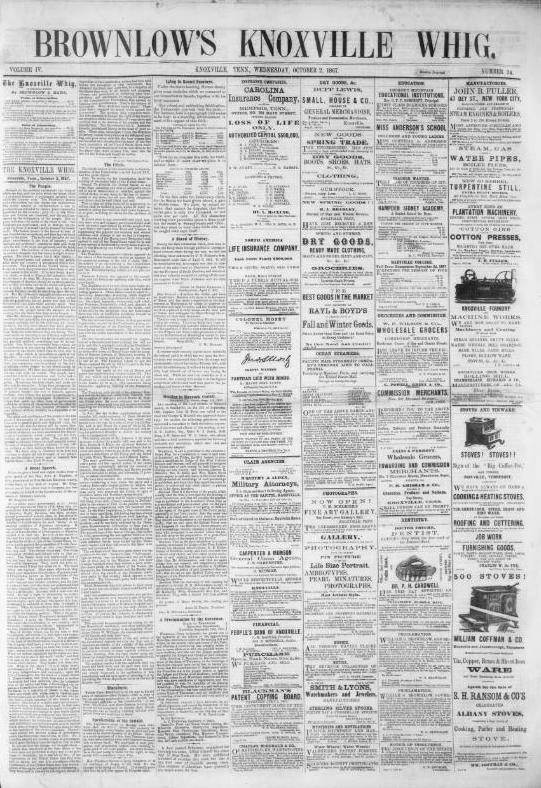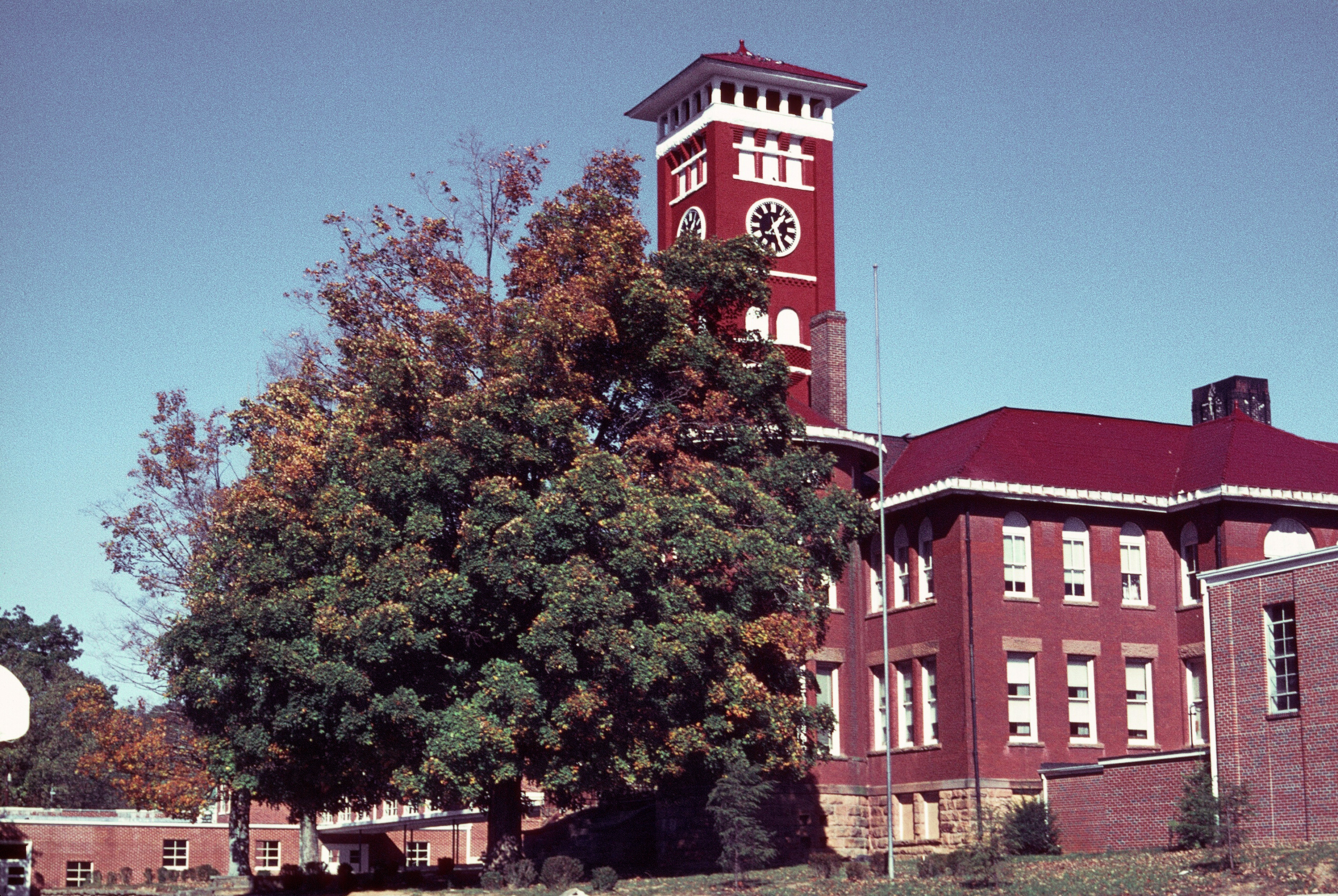|
Peter Staub
Peter Staub (February 22, 1827 – May 19, 1904) was a Swiss-born American businessman, politician, and diplomat. He immigrated to the United States in 1854, and moved to Knoxville, Tennessee, in 1856, where he lived for most of the remainder of his life. Staub served as mayor of Knoxville in the early 1870s and early 1880s, and built the city's first opera house, Staub's Theatre, in 1872. Staub also aided Swiss immigration to the Southern Appalachian region, helping establish what is now the town of Gruetli-Laager, Tennessee, in 1869. In 1885, President Grover Cleveland appointed Staub U.S. Consul to Switzerland.East Tennessee Historical Society, Mary Rothrock (ed.), ''The French Broad-Holston Country: A History of Knox County, Tennessee'' (Knoxville, Tenn.: The Society, 1972), pp. 489-490, 499. Biography Early life Born in Switzerland, Staub was orphaned when he was eight years old. At age 13, he was apprenticed to a tailor, and worked in this trade in France and Sw ... [...More Info...] [...Related Items...] OR: [Wikipedia] [Google] [Baidu] |
Canton Of Glarus
The canton of Glarus (german: Kanton Glarus rm, Chantun Glaruna; french: Canton de Glaris; it, Canton Glarona) is a canton in east central Switzerland. The capital is Glarus. The population speaks a variety of Alemannic German. The majority of the population (81%) identifies as Christian, about evenly split between Protestants and Catholics. History According to legend, the inhabitants of the Linth Valley were converted to Christianity in the 6th century by the Irish monk Saint Fridolin, the founder of Säckingen Abbey in what is now the German state of Baden-Württemberg. From the 9th century, the area around Glarus was owned by Säckingen Abbey, the town of Glarus being recorded as ''Clarona''. The Alemanni began to settle in the valley from the early 8th century. The Alemannic German language took hold only gradually, and was dominant by the 11th century. By 1288, the Habsburgs had claimed all the abbey's rights. Glarus joined the Old Swiss Confederacy in 1352 as one of t ... [...More Info...] [...Related Items...] OR: [Wikipedia] [Google] [Baidu] |
Brownlow's Whig
The ''Whig'' was a polemical American newspaper published and edited by William G. "Parson" Brownlow (1805–1877) in the mid-nineteenth century. As its name implies, the paper's primary purpose was the promotion and defense of Whig Party political figures and ideals. In the years leading up to the Civil War, the ''Whig'' became the mouthpiece for East Tennessee's anti-secessionist movement. The ''Whig'' was published under several names throughout its existence, namely the ''Tennessee Whig'', the ''Elizabethton Whig''. the ''Jonesborough Whig'', the ''Knoxville Whig'', and similar variations. The ''Whig'' was one of the most influential newspapers in nineteenth-century Tennessee, due mainly to Brownlow's editorials, which often included vindictive personal attacks and fierce diatribes. A Methodist circuit rider by trade, Brownlow partnered with publisher Mason R. Lyon under a one-year contract and launched the ''Whig'' on May 4, 1839 to counter rising Democratic sent ... [...More Info...] [...Related Items...] OR: [Wikipedia] [Google] [Baidu] |
Knoxville Fire Department
The City of Knoxville Fire Department is an ISO Class 2 department that provides fire protection and emergency medical services for the city of Knoxville, Tennessee. The department is responsible for with over 180,000 residents. History The Knoxville Fire Department can trace its beginnings to 1854 when Town Marshal J.D. Stacks saw the need for an organized volunteer fire department. But it was in March 1885 when the city of Knoxville formed a full-time, paid fire department. By the turn of the century, the number of firefighters in the department had grown to 30. With the increase in personnel came the need for more fire stations and better equipment. In the last 100 years, the Knoxville Fire Department has grown from the Headquarters station in an old livery stable building with two horse drawn engine companies and one aerial truck company to 19 fire stations, out of which 13 fire engines, 3 squads, 3 quints, 5 ladder trucks, 2 rescue units, and 1 hazmat company operate, along w ... [...More Info...] [...Related Items...] OR: [Wikipedia] [Google] [Baidu] |
Grundy County, Tennessee
Grundy County is a county located in the U.S. state of Tennessee. It is located in Middle Tennessee, bordering East Tennessee. As of 2021, the population was 13,622. Its county seat is Altamont. The county is named in honor of Felix Grundy. History Grundy County has a rich history and today is the home of a vast recreational wilderness known as the South Cumberland State Park which offers extensive hiking, camping, and rock climbing. Most of Grundy County is atop the Cumberland Plateau averaging a height of around 1,800 feet above sea level. Many locations in the county offer beautiful vistas and grand waterfalls. The county seat of Grundy County is Altamont, founded in the 1840s. Thirty years before the Civil War, the resort town of Beersheba Springs was founded around a natural mineral springs near the current site of a popular wilderness area known as the Savage Gulf. Visitors to the Savage Gulf are amazed by the beautiful views and extensive hiking trails. In the mid ... [...More Info...] [...Related Items...] OR: [Wikipedia] [Google] [Baidu] |
Cumberland Plateau
The Cumberland Plateau is the southern part of the Appalachian Plateau in the Appalachian Mountains of the United States. It includes much of eastern Kentucky and Tennessee, and portions of northern Alabama and northwest Georgia. The terms "Allegheny Plateau" and the "Cumberland Plateau" both refer to the dissected plateau lands lying west of the main Appalachian Mountains. The terms stem from historical usage rather than geological difference, so there is no strict dividing line between the two. Two major rivers share the names of the plateaus, with the Allegheny River rising in the Allegheny Plateau and the Cumberland River rising in the Cumberland Plateau in Harlan County, Kentucky. Geography The Cumberland Plateau is a deeply dissected plateau, with topographic relief commonly of about , and frequent sandstone outcroppings and bluffs. At Kentucky's Pottsville Escarpment, which is the transition from the Cumberland Plateau to the Bluegrass in the north and the Pennyril ... [...More Info...] [...Related Items...] OR: [Wikipedia] [Google] [Baidu] |
Theodore Thomas (conductor)
Theodore Thomas (October 11, 1835January 4, 1905) was a German-American violinist, conductor, and orchestrator of German birth. He is considered the first renowned American orchestral conductor and was the founder and first music director of the Chicago Symphony Orchestra (1891–1905). Biography Early life Theodore Christian Friedrich Thomas was born in Esens, Germany, on October 11, 1835, the son of Johann August Thomas. His mother, Sophia, was the daughter of a physician from Göttingen. He received his musical education principally from his father, who was a violinist of ability, and at the age of six years he played the violin in public concerts. His father was the town ''Stadtpfeifer'' (bandleader) who also arranged music for state occasions. Career Thomas showed interest in the violin at an early age, and by age ten, he was practically the breadwinner of the family, performing at weddings, balls, and even in taverns. By 1845, Johann Thomas and his family, convinced t ... [...More Info...] [...Related Items...] OR: [Wikipedia] [Google] [Baidu] |
Mendelssohn Quintette Club
The Mendelssohn Quintette Club (1849–1895) based in Boston, Massachusetts, was one of "the most active and most widely known chamber ensemble in America" in the latter half of the 19th century. It toured throughout New England and beyond, including Georgia, California and Australia. History According to one scholar, the popularity of composer Felix Mendelssohn in America "gained momentum sharply after 1848, when more German musicians, some of whom had been Mendelssohn's pupils, emigrated to America. ... Influential ... was the Mendelssohn Quintette Club, which presented early American performances of several of Mendelssohn's works, including the Quintet in A major, Op. 18, with which the ensemble opened its first concert in 1849." The Quintette consisted of Thomas Ryan, August Fries, Francis Riha, Eduard Lehmann, Wulf Fries, and others through the years. The group performed in Boston at Cochituate Hall, Boston Music Hall, Chickering & Sons' Hall, and the Melodeon; and outside ... [...More Info...] [...Related Items...] OR: [Wikipedia] [Google] [Baidu] |
William Tell
William Tell (german: Wilhelm Tell, ; french: Guillaume Tell; it, Guglielmo Tell; rm, Guglielm Tell) is a folk hero of Switzerland. According to the legend, Tell was an expert mountain climber and marksman with a crossbow who assassinated Albrecht Gessler, a tyrannical reeve of the Austrian dukes of the House of Habsburg positioned in Altdorf, in the canton of Uri. Tell's defiance and tyrannicide encouraged the population to Burgenbruch, open rebellion and a Rütlischwur, pact against the foreign rulers with neighbouring Schwyz and Unterwalden, marking the foundation of the Old Swiss Confederacy, foundation of the Swiss Confederacy. Tell was considered the father of the Swiss Confederacy. Set in the early 14th century (traditional date 1307, during the rule of Albert I of Germany, Albert of Habsburg), the first written records of the legend date to the latter part of the 15th century, when the Old Swiss Confederacy, Swiss Confederacy was gaining military and political influ ... [...More Info...] [...Related Items...] OR: [Wikipedia] [Google] [Baidu] |
William Tell (1825 Play)
''William Tell'' is an 1825 historical play by the Irish writer James Sheridan Knowles. It portrays the legendary 14th-century Swiss folk hero William Tell in his battle against the Habsburg authorities. It premiered at the Theatre Royal, Drury Lane in London. The original cast starred William Macready as Tell and included Thomas Archer, Henry Gattie, Edward Knight, Elizabeth Yates, Clara Fisher Clara Fisher (14 July 1811 – 12 November 1898) was a British prodigy who, at the age of six, began performing on the London stage in 1817. Ten years later, she made her New York debut in 1827. Her acting career lasted for 72 years and in he ..., Charles Mayne Young and Margaret Agnes Bunn. Knowles dedicated the play to the Spanish opposition leader General Francisco Mina, then living in exile in England. The play was a success established Knowles as the leading dramatist of the period. Revived frequently, it became a standard in both Britain and North America.Lerg & Tóth p ... [...More Info...] [...Related Items...] OR: [Wikipedia] [Google] [Baidu] |
James Sheridan Knowles
James Sheridan Knowles (12 May 1784 – 30 November 1862) was an Irish dramatist and actor. Biography Knowles was born in Cork. His father was the lexicographer James Knowles (1759–1840), cousin of Richard Brinsley Sheridan. The family moved to London in 1793, and at the age of fourteen Knowles published a ballad entitled ''The Welsh Harper'', which, set to music, was very popular. His talents secured him the friendship of William Hazlitt, who introduced him to Charles Lamb and Samuel Taylor Coleridge. He served for some time in the Wiltshire and afterwards in the Tower Hamlets militia, leaving the service to become a pupil of Dr Robert Willan (1757–1812). He obtained the degree of M.D., and was appointed vaccinator to the Jennerian Society. Although Dr Willan offered him a share in his practice, Knowles decided to give up medicine for the stage, making his first appearance as an actor probably at Bath, and played Hamlet at the Crow Theatre, Dublin. At Wexford he marrie ... [...More Info...] [...Related Items...] OR: [Wikipedia] [Google] [Baidu] |
Thomas Amos Rogers Nelson
Thomas Amos Rogers Nelson (March 19, 1812 – August 24, 1873) was an American attorney, politician, and judge, active primarily in East Tennessee during the mid-19th century. He represented Tennessee's 1st Congressional District in the 36th U.S. Congress (1859–1861), where he gained a reputation as a staunch pro-Union southerner. He was elected to a second term in 1861 on the eve of the Civil War, but was arrested by Confederate authorities before he could take his seat. As early as the 1830s, Nelson had gained a reputation as an effective Whig Party campaigner, but due to family considerations, he did not run for office until 1859. In December of that year, Nelson gained international renown for an explosive anti-secession speech he delivered before Congress. As president of the East Tennessee Convention, Nelson campaigned to keep Tennessee in the Union, but maintained a neutral position after his arrest. After the war, Nelson opposed the radical initiatives of his ... [...More Info...] [...Related Items...] OR: [Wikipedia] [Google] [Baidu] |





